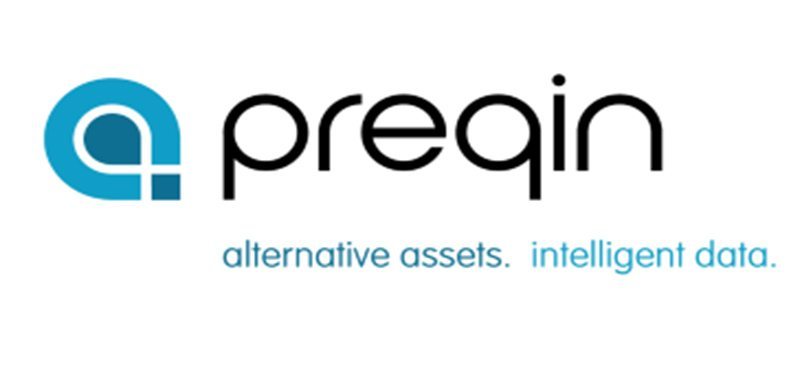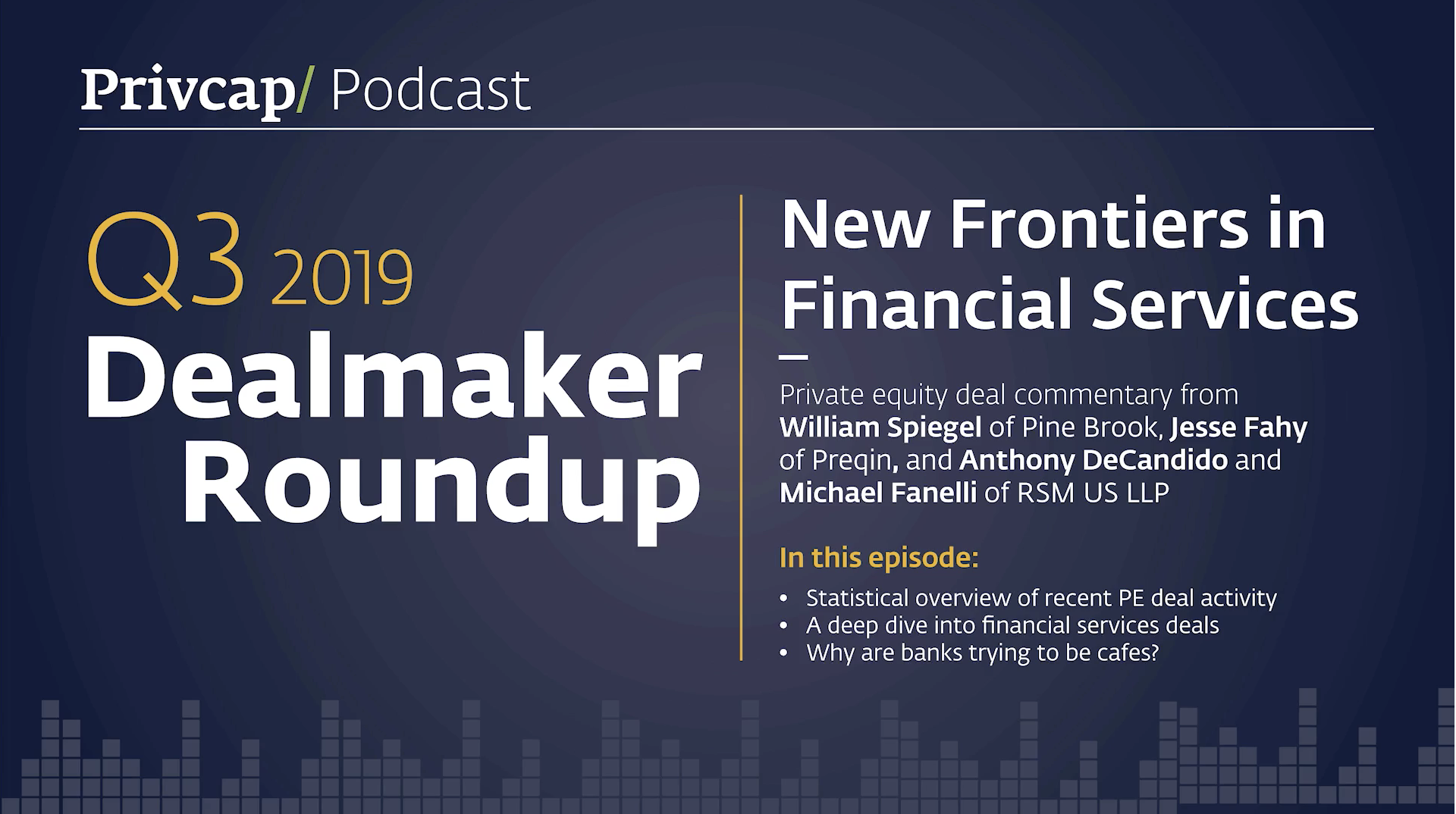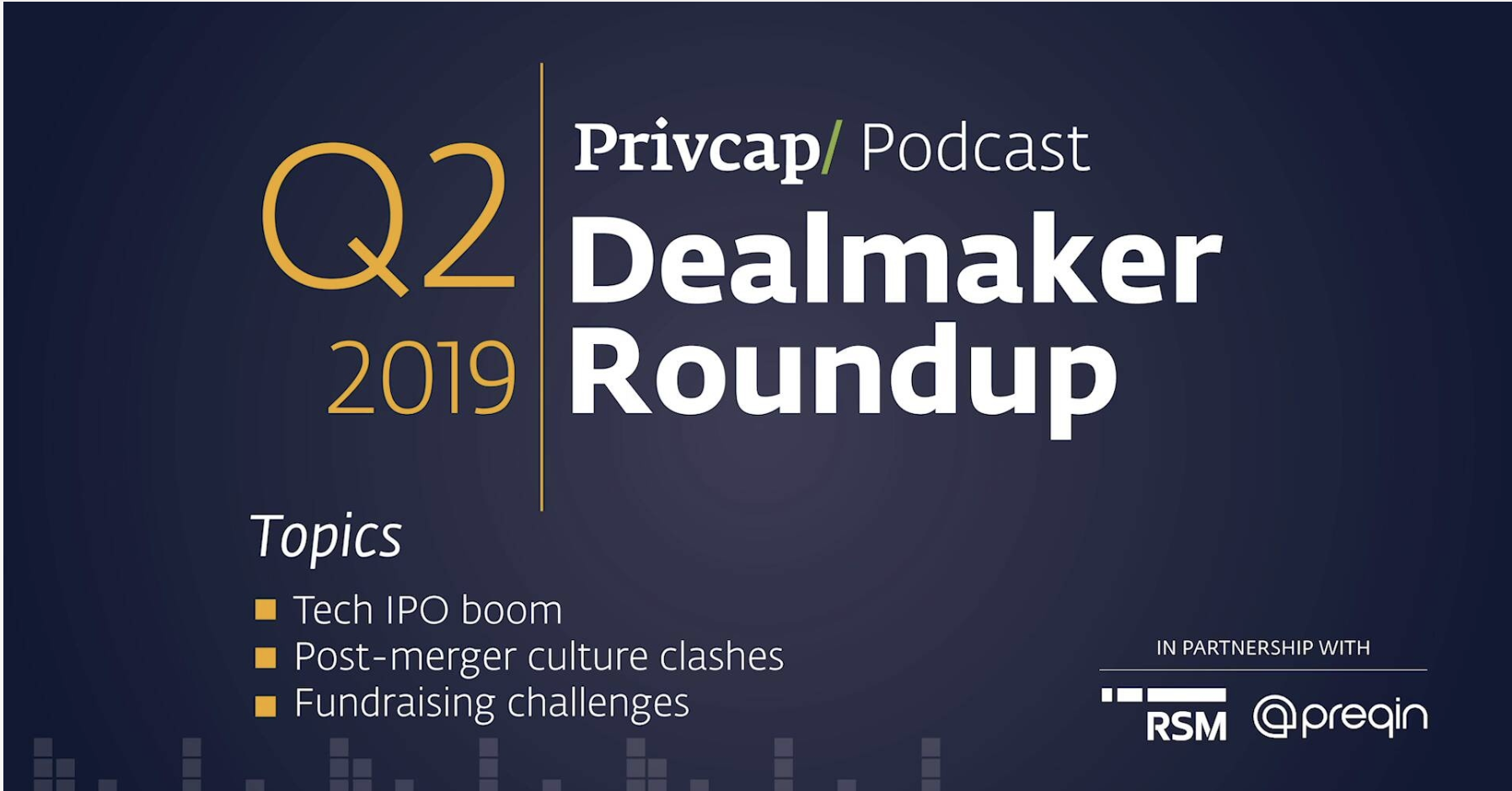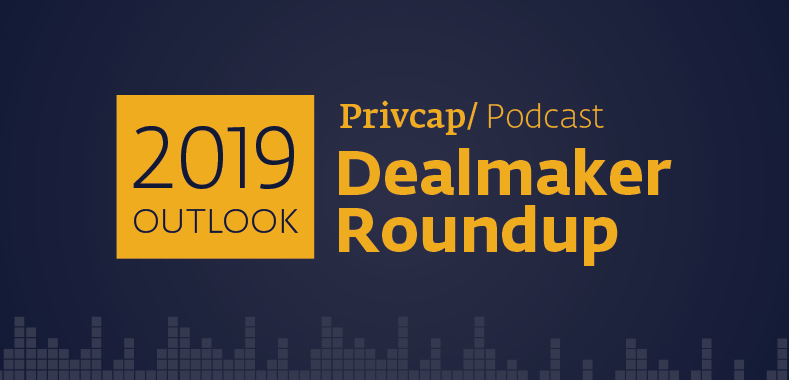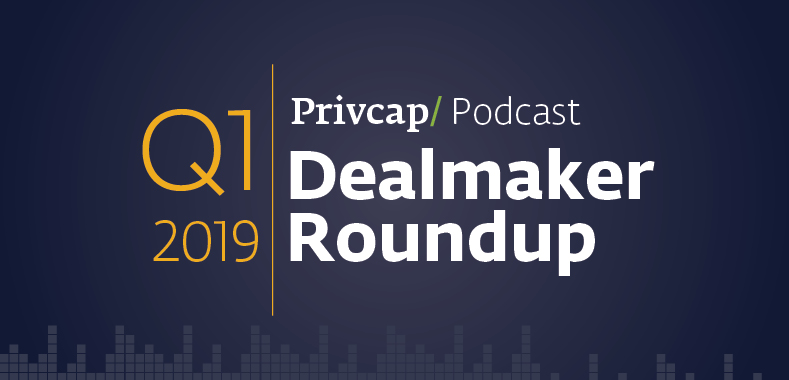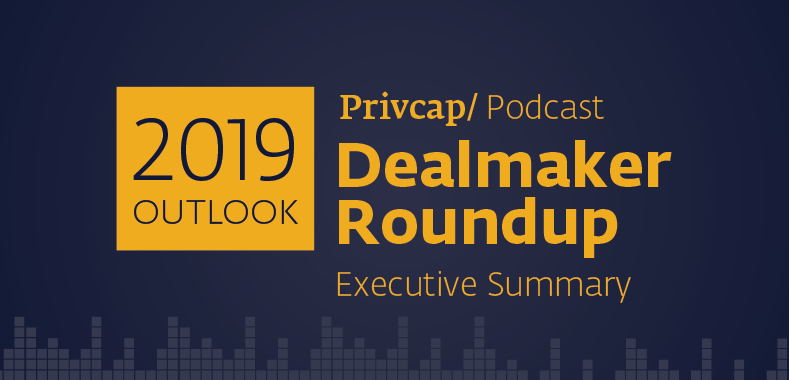Dealmaker Roundup: Q1 2019
Are sky-high multiples of EBITDA the new normal? The rise of non-bank lenders. Three experts discuss.
Transcript Download Transcript
Dealmaker Roundup Q1 2019
David Snow, Privcap:
Hello and welcome to Privcap. My Name is David Snow and today we’re joined by three experts of the private equity deal market: John Neuner of Harris Williams, Jesse Fahy of Preqin and Michael Fanelli of RSM. Gentlemen, welcome to Privcap today.
Unison: Thanks for having us.
Snow: We are now one quarter deep into 2019 and the private equity deals market is still very robust, especially in the middle market. I’d love to hear from the three of you—just what you’re hearing from participants in the market, in the spectrum between caution and confidence. Where do you think we are right now? Because obviously the deal-making party can’t last forever. This ultimately is a cyclical market. Maybe we could start with John Neuner from Harris Williams.
John Neuner, Harris Williams:
Sure. Happy to. As you said, we saw really pace pick up a fair bit over the last 60 days. As we came into the first part of the year, even though overall volume] has been pretty solid for the quarter, you actually started off pretty slow at the beginning with a little bit of a hangover … sluggish end of the year and a bit of a slow start at the beginning. And then, it really picked up pace as we came through it and it really has picked up steam with some good quality companies. And we continue to see activity—both deals getting done as well as pitch volume showing a good pace coming into it. And we’ve tended to see as well over time—we’ll talk about multiples have accreted up, processes have gotten a bit more narrow, more targeted. There’s still a very active market out there for folks that are interested in acquiring companies. And you’re looking at that market is growing every day—as the number of people that are investing capital take on various shapes and forms and sizes continues to add capital to their arsenal and look for good quality companies.
At this stage, we see people being cautiously optimistic, picking their spots where they feel like they can add real value. But we’ve continued to see people aggressively pursuing deals where they feel good about the opportunities that those companies provide them to make money.
Snow: Michael Fanelli from RSM, what are you seeing from your vantage point?
Michael Fanelli, RSM:
I’m cautiously optimistic. That’s the first bullet point I have written down here in my notes. Because there’s a tremendous amount of optimism and confidence in the marketplace right now. Obviously, there’s a little bit of caution in the background just to ensure that the global economy can continue to trudge forward with everything that’s going on in the world right now.
But, in terms of the middle-market M&A, it’s a bit of a broken record-type of scenario, but it continues to remain hot. And we’re seeing … more auction processes than I think we ever have. There’s just so many buyers out there seeking companies to acquire, whether they’re family-owned businesses or acquiring from another private equity firm or doing carve-outs from public companies. Just seems like every seller is well-banked and well-served from an advisor perspective.
Michael Fanelli: We’re seeing a tremendous amount of auction processes, which drives even further competition in the marketplace. There’s a lot of times where multiple buyers are coming down to the end game as opposed to having one potential buyer have an elongated exclusivity arrangements. So I would phrase it over overall as cautiously optimistic, but everyone’s continuing to put money to work here.
Snow: And Jesse Fahy from Preqin, as a keeper of the statistics of private equity and alternative broadly, are you seeing anything new or interesting or unusual in the numbers?
Jesse Fahy, Preqin:
The numbers speak for themselves here. Q1 was a little bit of a letdown, kind of off our historic deal activity in 2018, but we still clips to a $100-billion mark. And deal value for the 6th time or last eight quarters. So, very healthy market overall on its own. We had a great Q1; however, that was based largely off the strength of larger average deal sizes rather than off the level of value. If you look at the sheer number of deals, we have to go all the way back to Q1 2015 to find a less active quarter than the 1,100 deals that took place over the last three months. A good amount of that slowed down. We think it’s attributed to Europe, which after seeing an all-time high of $53 billion in deal value in Q1 of 2018, we had that finger drop all the way. We had that figure job every subsequent month to just $19 billion Q1 this year. That’s definitely attributed a lot to the overall slowdown from our 2018 highs. Then, just talking about an investor sentiment, echoing what my fellow panelists said, some cautious optimism. During a recent fund manager survey, 63% of managers we asked cited valuations as the primary challenge they’re looking to face on returns in 2019.
The next popular responses after that worth over a third of responses to them was the Brexit environment, a geopolitical landscape, and also competition for in that order. Then, another 43% they felt assets were currently overvalued and then a correction was either imminent or coming in the next 12 months. So, while the market is strong overall, I definitely think we’re seeing more cautious optimism and a little fear is creeping up that things might be closer to return than they were at this point last year.
Snow: Let’s move on to this subject of prices and valuations for these private company sales. The value of a private company transaction is often measured in the multiples of EBITDA, multiples of earnings paid for that company. According to information from Harris Williams, we’re now seeing average multiples of EBITDA in these transactions of 10.6 times EBITDA , which is robust. So, I’m wondering, and maybe we’ll go back to John, whether you see any important information in that average or whether there’s more nuance that needs to be put into to it. Because, at first glance, it looks like buyers of these private companies are paying very, very robust multiples.
Neuner: Sure, absolutely. We’ll look at—we are in a great evaluation point in time, a relative to historic levels. Now, where we haven’t been here before, but we continue to be at an elevated level, but frankly a level that is not likely to change. And we can talk about structurally what’s shifted in the market as people look at some of these companies. But first, as we talk about the metric and the number in terms of the EBITDA multiple minutes, it’s easy to sit there and it’s the simplest way for people to talk about, “How do we sit there and take an earnings base and the EBITDA? And how do we put a multiplier on it to sit there and try to make things comparable across companies?” There’s a lot more art than science, if you will, to how people are coming up with evaluations today and, frankly, how people are thinking about the world.
Structurally, around a lot of these companies you’ve seen a variety of things change and evolve in the deal world. Process today is not the same as the process five and 10 years ago or even 30 years ago as the whole private equity world was more in its infancy. Today, people that are buying these companies have historically been tracking them for several years. They’re much more targeted in terms of the segments they’re focused on and where they feel like they can add value. So, it’s as much around what’s not so much “What am I paying for it because I need to be cognizant of that?” But if you buy a good company and you’re confident, you can do great things with it. Ultimately, investors are rewarded on the value that they create over time. So, it’s people being confident where they can take those companies. You’ve also had a lot more history in the private equity world today where you know, 30 or 40 years ago, you didn’t know what the risk profile of what a private deal was and how to think about illiquidity, discounts and things of that nature.
Today, it’s been a much more proven asset class with a lot more data points, with a lot more trend and track record in these companies. And it’s given the maturation of that relative to options and alternative and the public market have really created an environment where people are more confident in creating their outcome and, therefore, they’re able to pay more on the front end for the opportunity to create that outcome for great companies.
Snow: Interesting. Mike Fanelli from RSM, what’s your take on the current, elevated valuations that are being paid by private equity firms and other private buyers. As John mentioned, are we possibly in a permanently elevated step change.
Fanelli: Yes. I think it’s going to take a significant market downturn to really change the multiples. And the reality is people are comfortable selling to private equity. And John mentioned it in terms of how private equity in the overall—especially in the middle market, M&A marketplace—has evolved over time. Sellers are simply more comfortable selling to private equity than they were five and 10 ago. And definitely 20 years ago.
I think the EBITDA multiples are the new normal. I don’t think it’s some peak number. It seems like a new normal to me. The interesting stat that was put forth was that that multiple that you reference of 10-6 was for sponsor-backed LBOs under $50 million of EBITDA, which is good, but where buyers will buy or you’re trying to do now is to get some level of multiple arbitrage doing roll-up strategies with add-on acquisitions. So, there is a little bit of arbitrage to get in the lower middle market. So, you might buy a $50 million EBITDA business at 11 times, but is it in a fragmented business where you can do an add-on strategy in a roll-up strategy of other like businesses that might be $10 million of EBITDA or less at six or seven times EBITDA? So, your total EBITDA multiple in at the end of the day is sub-11 and then they can sell it at four, 11 or higher, with a little bit of top-line growth. You’re looking to be sitting pretty at the end of the day.
So, that’s helping a lot in the current marketplace. There’s simply a ton of buyers out there. One of the fundraising staff that saw with Preqin—which I thought was really interesting—is of funds raising by year and the total aggregate capital. You’re talking about 1,300 in January 2014 to 4,000 or 3,900 or 4,000 in the current month of April 2019. There’s a significant amount of new funds out there and/or funds raising second, third, fourth and fifth funds. So, the total amount of capital out there and the total number of the buyer pool has been raised to generate the ultimate level of competition for middle market M&A.
Fahy: Yes. It really speaks to the current environment we’re in right now. I think we’re at an inflection point where we’re looking at a new normal or perhaps a return to the norm—multiple paid for private assets overall as either add or near historic highs, both absolutely and also in relation to public assets depending on the figures you look at. Some private equity multiples are actually surpassing some of their public asset counterparts. [That’s] something we’ve really only witnessed before in the mid-‘80s and also in the lead-up to the global financial crisis.
The reason that shouldn’t happen is fairly clear. The public assets you’re paying a premium for, liquidity and increased transparency, that’s offered, that parents less competition for the assets should preclude private assets from going more private than public.
However, due to the abundance of dry powder, which had 1.2 trillion midway through last year, as well as our best credit market that’s happy to finance these deals, that logic no longer necessarily holds true. As for what it tells us about the current environment, you were doing their point to us being at a market top as it did in the ’80s and the mid-2000s, or possibly, as has been alluded to here, the ushering in of a new normal where IPOs are going to become more and more scarce. Mega funds are going to continue to grow in both abundance and also their average size and eventually private capital opening up more to retail investments tells us all about this change.
Snow: Great. Let’s move on to our final topic and that has to do with something Michael Fanelli mentioned earlier, which is the growing importance of non-bank lenders. So, there’s all these private companies out there that are hoping to make loans to help back acquisitions and certainly private equity deals. And I wonder if the growing prominence of these non-bank lenders tells us something about where we in the cycle or if we think this is the new normal? These are permanent new players in the private equity deals market and we should expect their involvement in these deals to be a longstanding part of the market. Maybe going back to John from a Harris Williams.
Neuner: Yes. As we’ve seen more broadly, we were talking earlier about what we see in the proliferation of private equity and private capital from an equity perspective. You’ve seen very similar things from the debt perspective—people have come in and started new funds, new pools of capital, new pockets of capital, how to go use it. You’ve seen funds that have spun off from other funds and people can have created their own firms along the way. And I think what it’s created is a lot more flexibility in the capital structures that are available out there. The willingness of people—if you think about the Unitron senior stretch, the multitude on any given deal of types of structures in the capital credit availability, as well as where it’s coming from, has been more diverse than we’ve seen over the last five and 10 years.
The ability for people to again think creatively depending on what their investor return profile is in for these non-bank lenders—it gives them the opportunity to think longer term and be flexible as we go back to things like not having covenants and being willing to ride something if there is an economic blip or something that impacts the company. It gives them the flexibility and they’re wanting to think longer term as I go to it.
So, we definitely think … that has been helpful for an overall market from a liquidity perspective in terms of supporting the increasing volume of deals that are out there in the market and also giving people more of a variety. And people definitely do want to feel like … they are still very much of a relationship-driven business too and a lot of what we do—the “process” word can sound very static and process has actually shrunk a fair bit and gotten much tighter. That’s not just as we create relationships within private equity, but it’s also the private equity of their capital suppliers and with people that are go-to in terms of helping them put together the best package and deal as they look to support their company’s long term. Both banks and the non-bank lenders have a big piece of that market, but it has definitely shifted to where non-bank lenders have taken over the biggest chunk of the market.
Snow: Mike from RSM, from your vantage point, what’s notable about the participation of these non-bank lenders in the private equity deals market?
Fanelli: I don’t know if I’m just simply confident enough to say this or naïve, but it feels like this is the new normal. We are seeing the significant majority of middle-market deals being backed from a debt perspective by non-bank lenders. When we do a buy-side due-diligence process, many times, our report is read by the lenders they can’t rely on, but they read it and they have a call with us. So, we get to see the lender pool on many of these transactions. And the significant majority of them are these non-bank lenders and many of them are large private equity firms with a debt fund. I think some of the things John mentioned—better general understanding of the private capital markets and the flexibility of a longer-term thought process is actually probably better for the companies themselves and the private equity firms to support the transactions over time, as opposed to a traditional bank who might think more short term and have different things in place where they might be pushing back on short term-type lips.
A lot of them have made a decent enough return where it’s good for them both short term and long term—“they” being the non-bank lenders. Some of them are even being paid back faster than originally anticipated. Then, two recapitalization subsequently and being flexible from that perspective as well. So, to me, this is another situation that is the new normal in middle-market M&A.
Snow: Any final observations to make before we sign off?
Fahy: As has been mentioned here, I think … that’s something on reflection point in the market where we have record levels of dry powder sitting in the sidelines and GPUs need to put this money to work regardless of where you are on the market cycle. So, I think it will be very telling within the next year or so whether, as Michael put forward, are we in the new normal with these multiples or are we possibly at a market top? It’s definitely something to watch.
Fanelli: We would agree. We continue to see the inbound tracker and not just the deals getting done right because that’s tracking what has happened to the quarter as we go through it, as we think about both deals in our backlog, deals and pitch volume, the volume of activity and conversation we’re having out there. The cadence continues to be very strong in terms of the dialogue, not just putting money to work, but people tracking businesses. How much farther they’re getting out in front of these companies. How they’re thinking about these companies and being thoughtful about creating value down the road. And that’s the true where the rubber will hit the road is—we’ll have your economic times, they’d come and go. As we look back, the last one we went through almost a decade ago was atypical in terms of what felt they’ll look like. I don’t think people are expecting that as something that is in our near future as we go through it. But it feels like people are really taking the time to be thoughtful in terms of how do you transform it? How do you really take these businesses they acquire? Because, then, people are paying good valuations for them and really create value in those companies. And the levers that are being pulled today, the thought processes in it. We’re not in the financial engineering that this industry was 20, 25 or 30 years ago. This is real strategy. Bringing in people from industry that are former executives and operating partners and really taking the deep dive and helping transform and change these companies. That’s what’s giving people confidence that there are still a ton of opportunities as companies progress through their chapters of growth.
Fanelli: How each of these different vehicles—whether it’s private equity, family-held offices, patient capital, whatever you want to call it in terms of the capital—how they can add value along that spectrum and be a good steward of that company while they own it. That’s continued to prove out. And that’s, to the comment early on, what secondary buyouts have continued to be a bigger piece of it—you get higher confidence in terms of having seen what the prior person did. Not only you’re getting a good company, but also having a good feel for what is it I can do this different than the last person to keep growing these businesses. That’s where our industry has continued to evolve and transform and enable these companies to stay private longer.
Because when you look at it compared to other liquidity options, the IPO markets are down in terms of volume that’s out there. The number of public companies is lower. People want to keep these companies private longer and these pools of capital that are being grown—even some of the capitalism being raised—the multibillion-dollar mega funds are increasing, when you actually look at the stats in terms of the size of their next funds. So, the view is more companies will continue to stay private and continue to drive this private M&A market for a long time.



